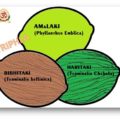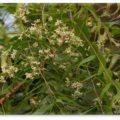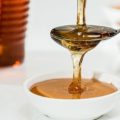Ancient Indian medicinal text, Ayurveda is filled with hundreds of medicinal plants, herbs and fruits that are responsible for healing some of the most difficult health conditions.
It really take a lifetime of commitment, dedication and insight to really comprehend the glory of Mother Nature and it’s natural wonders to make use of it’s rich knowledge for the upliftment of human life. Ayurveda has always been helpful in giving us a deep perspective of how to make the best use of natural wonders like local plants, fruits and herbs in various forms for improving life as a whole.
In this article we are going to cover just 3 of the most profound creations of nature in the form of fruits.
These three miraculous fruits in combination called “TRIPHALA”, which have multiple benefits for human health. So, let’s get started immediately…
Table of Contents
Amla (आवळा) Indian Gooseberry –
Botanical name = Phyllanthus emblica
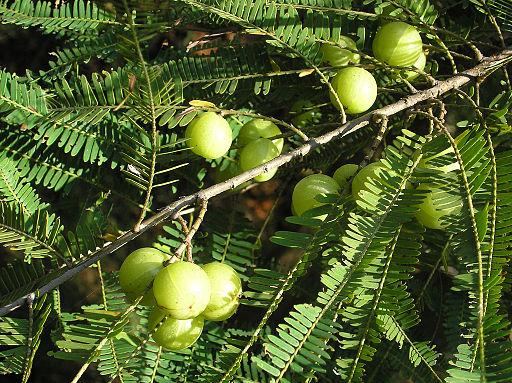
Amla or Amalaki is a renowned Ayurveda medicine consider as both medicine and food. Amalaki is one of the three herbs included in Triphala.
Indian gooseberry (Amla) highly contains vitamin C with its antioxidant property.
The amla fruit is eaten raw or cooked into various dishes. This is the main ingredient in the nutritive jam ‘CHYAVANPRASH’.
In traditional Indian medicine dried and fresh fruits of amla are used. All the parts of the plant are useful in various ayurvedic medicine preparations.
Latin name: Emblica officinalis / Phyllanthus Emblica.
Sanskrit : Amalaki
Family: Euphorbeaceae
Parts useful: All the parts of plant / specially fruit.
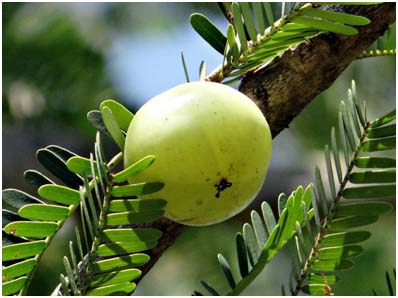
Why is Amla a medicinal fruit as per Ayurveda?
Amla literally means ‘Sour’. Other Sanskrit name of amla literally means ‘MOTHER’, ‘NURSE’ & ‘IMMORTALITY’.
It performs the job of taking total care of the mind – body system with immune restorative property.
“आमलते धारयती शरीरमवा रासायनगुनाण”| भावप्रकाश
“amalate dharayti shariram va rasayangunan” | Bhavprakash
Amla is also renowned for its immunity and anti aging benefits. This is called RASAYANA therapy in Ayurveda. The father of Ayurveda medicine CHARAKA has described Amalaki as the best among rejuvenate herbs.
The main quality of amla is VAYASTAPANA, which means stopping the aging, which improve one’s longevity too. As per chemical formulation, it highly contains vitamin C. 100g amla contain 600-921 mg vitamin C. It also contains tannin, pectin, glucose, Gaelic acid.
What are the qualities of Amla?
As per acharya Charaka :
Rooksha – Dry
Kashay – astringent
Madhur – sweet
Balances kapha and pitta.
What is the taste of Amla ?
Rasa (taste) : Sour, sweet, pungent, bitter, astringent.
Virya (action) : Cooling
Vipaka (post-digestive effect): Sweet
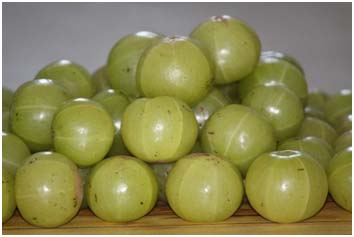
How it is used? In which forms, powder, juice, raw, paste?
Fresh fruit is best form to enrich all nutrition. But if you cannot find the fresh one, you can eat it in dried powder, as a salad, pickle or juice form. We can enjoy Amla in various forms and various ways.
Amla is used to cure which diseases?
Amla is quite similar to quality of Haritaki.
Sarvadoshagna : Amla balances Tridosha, just the way, time and method of consumption is differed as per dosha and prakriti.
हरीतकीसम धात्रिफल किंतु विशेषत:| रक्तपित प्रमेहघ्न परं वृष्यं रसायनं ||
हंति वातम तदअम्लत्वातपित्तम माधुर्य शैत्यत: | कफ रुक्ष कषायत्व फल धात्र्यं स्त्रीदोषजीत || यस्य यस्य फलस्येह वीर्यम भवति यादृश्यं ||
- Raktapittam: Useful in all bleeding disorder
- Pramehaghna: Diabetes along with urinary problems
- Vrushya: Aphrodisiac
- Rasayana: for rejuvenation, anti-aging,skin and hair problems
- Chakshushya: Eye disorders
- Kanthya: Respiratory problems with all throat diseases.
- Useful in digestion, constipation
- Amlapitta: Acidity
- Stri-doshjit: Female disorders
- Useful for weight loss&weight gain too
- Hrudya: Good for heart
- Jwarahara: Useful in fever.
- Medhya: Useful to improve grasping power.
- Useful in scurvy
- Useful in stomatitis.
Are there any side effects of Amla?
- Amla is sour in taste and cool in property and because of this quality if person with cold and cough may worsen there symptoms, so taking amla alone in that condition is worse.
- Consuming more fresh amla fruit in one day causes skin dryness or hair dryness. Dryness is associated with coldness, hence vata people should be very careful with this. Or consume amla along with ghee is a better choice.
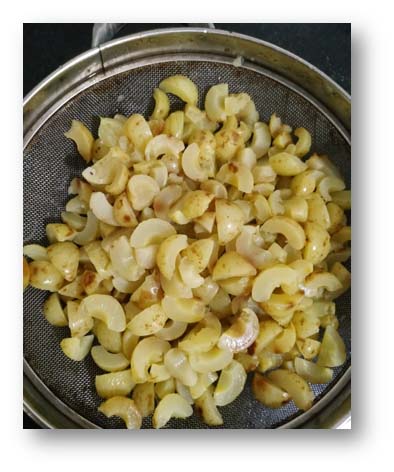
Is Amla used alone or in combination with other fruits or ingredients?
We can use amla alone & with some combination also depending upon the doshas and the symptoms of a person
For example :
- Amla powder with honey or jaggery acts as a blood purifier.
- Amla along with Behda and Hirada know as ‘Triphala’ cures and is beneficial for all types problems and balancing tridosha.
- Amla juice along with salt and pepper boosts the digestive fire and act as a natural laxative like Triphala.
- Amla with other ingredients like curd or Shikekai is used for external application and act as a natural hair cleanser and relives dandruff.
- Consumption of amla with ghee and saffron internally work as a natural skin purifier.
- Intake of amla powder with 1 tsp ghee and 1/2 tsp honey at night improves vision.
Amla with yogurt is applied on scalp for dandruff removal. - Amla with aloe vera juice is good for skin, hair and liver issues.
- Amla hair oil is useful in hair fall, dandruff, dry and rough hairs.
Are there any recipes of amla?
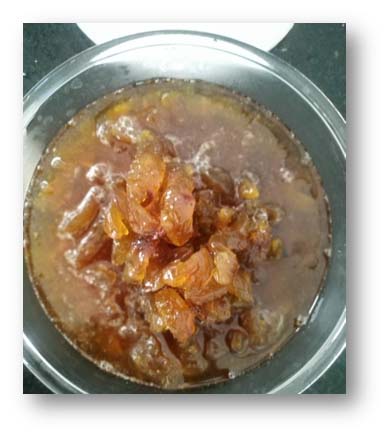
One of the famous recipes in Ayurveda is made with 500 amla along with more than 45 herbs called ‘CHYAVANPRASH’. This is called Rasayana medicine which acts as a rejuvenating and anti-aging element.
- Amla juice – relieves acidity, boosts energy, improves hair and skin problems, reduces fever, increases lifespan, and alleviates kapha dosha.
- Amla candy– Made with sugar or jaggery, is good for acidity, digestion problems, gastritis and to gain weight.
- Murabba (moravala) – Made with sugar syrup, clove, cinnamon helps to improve vitality, gives nutrition, highly rich in vitamins, relieves acidity and lethargy.
Hirada (हिरडा)
Botanical name = Terminalia chebula

Haritaki is a very famous rejuvenating food which in combination with amla and Behda forms ‘Triphala’. Also named as chebulic myrobalan in Latin.
हरीतकी पंच रसा अलवणा तुवरा परम |
Haritaki contains all five Rasa (taste) {Sweet, Sour, Astringent, Bitter, Pungent} except SALT {Lavana} with stronger taste of Astringent.
It is considered ‘Tridoshic’ meaning it has capacity to balance all the three doshas- vata, pitta, kapha.
Why is Hirada a medicinal fruit as per Ayurveda?
Pharmacological activities of Haritaki are anti-oxidant, anti-viral, anti-inflammatory, laxative, anti-cancer, antiviral, wound healer, anti-fungal, immuno modulator.
Latin name : terminalia chebula / chebulic myrobalan
Sanskrit name : Haritaki
Family name : Combrataceae.
Useful parts : All the parts of plant / specially fruit.
In ancient Ayurveda text book there are 7 types of Haritaki found with following names :
- Vijaya – Found in vindhya mountain, appear like a bitter gourd, useful in all types of diseases.
- Rohini – Available every place, shape like a round fruit, useful in wound healing.
- Putana – available in Sindh area, resemble small fruit with big seed, useful in external application for skin.
- Chetaki – Available in Himachal Pradesh, appear with three creases on fruit, useful for purgation.
- Amruta – Available in champa, Bhagalpur area, appear huge, useful in panchakarma (detox treatment).
- Abhaya – Available in champa, Bhagalpur area, with five creases,useful in ophthalmic disorders.
- Jivanti – Available in region of Gujrat, yellow colored fruit, useful in all disease.
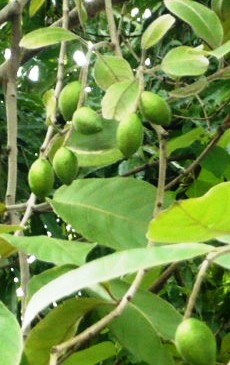
How does Hirada taste?
Rasa {Taste}: All five tastes except salt {sweet, sour, astringent, bitter, pungent}.
Virya {action}: Ushna {hot)
Vipaka (post-digestive effect): Sweet
What are the qualities of Hirada?
रुकशोषना दीपनी मेध्या स्वादूपाका रसायनी | चक्षुश्या लघु आयुष्य बृहणी च अनुलोमणी ||.. मूत्रघातशच नाशयेत || भावप्रकाश 19-22
- Laghu – Lightness
- Rooksha – Dryness
- Ushna – Hot in nature
- Sara – Promotes bowel movements
- Doshaghna – Natural detoxifying
- Deepana – Improves digestive strength.
- Pachana – Digestive
- Rasayan – Rejuvenate, anti-ageing
- Medhya – Improve intelligent
- Bruhani – Nourishing
- Anulomani – Help in purgation
- Lekhaniya – Helpful in fat scarping
- Shothahar – Helpful in inflammation
- Balaprada – Promote physical strength
- smritiprada – Improves memory
- ayushya – Longetivity
- Varnya – Improves skin complexion.
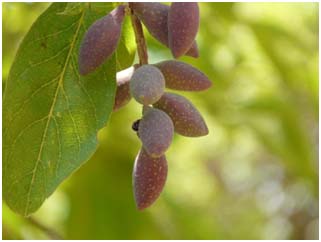
Hirada is used to cure which diseases?
- Shwas / kas – Al respiratory tract infections
- Prameh – Diabetes
- Arsha – Hemorrhoid
- Kushtha – Skin disorders
- Shoth – Inflammation
- Krimi – Intestinal worms
- Adhman – Distention of abdomen
- Gulma – Abdominal tumor
- Swarbhed – Throat infection
- Vishamjwar – All types of fever
- Yakrit-pliha vruddhi – Splenomegaly and hepatomegaly
- Ashmari – Kidney stone and all urinary infections
- Pittanashak – Relieves acidity
- Kaphanashak – Reduce kapha
- Akshiroga – Eye disorder
- Grahani – IBS
- Hridroga – Heart disease
How is Hirada used? In which forms, powder, juice, raw, paste?
Hirada can be taken in many form and is health beneficial with proper knowledge of doshas and dosage.
As per acharya Bhav-prakash –
- After chewing whole fruit – improves digestive power
- After scraping on harder surface – acts as purgative
- After boiling – anti-diarrheal
- Roasted form – balance three dosha -vata, pitta, kapha.
- Consumption with meal – improve intelligence , strength, digestion & all sensory and motor organs. Even act as a purgative.
- After meal consumption – helpful in all digestive problems, balance three-dosha along with their disorders.
- Along with ghee – reduce all vata disorders
- Along with jaggery – reduces all three-dosha disorders
- Along with salt – reduces kapha disorders
- Along with sugar – reduces pitta disorders
Are there any side effects of Hirada?
It has multiple health benefits but because of astringent taste and hot potency it is avoided in some cases :
- People who have walk for very long and who are very tired.
- Patient who have depleted their immunity and strength.
- Having lean body / in weight loss cases.
- Who have done a fast for longer duration.
- Who feels dry and emaciated.
- In pitta people who feel burning sensation.
- In pregnant women.
- After menstruation, blood letting treatment.
- During thirst, hunger, and got exposed to sunlight for long time.
- Patient suffering from indigestion.
- People with neck stiffness.
- People who have mouth ulcers.
- In early stage of fever.
- Person who is emaciated due to alcohol and sexual activity.
- For children and pregnancy it should be give under medical supervision. Only Haritaki alone is contraindicated in this cases.
Is Hirada used alone or in combination with other fruits or ingredients?
Hirada alone or with combination of other herbs are always helpful for lots of diseases.
Acharya Bhav-prakash explains RUTU-HARITAKI as a seasonal regimen for Haritaki for the purpose of Rasayana (rejuvenation and anti-ageing).
In each and every season Haritaki can be taken with different ingredients to improves health of body called RUTU- Haritaki.
- Shishir rutu (winter season) -along with long pepper (pippali)
- Vasant rutu (spring season) – along with honey (madhu)
- Grishma rutu (summer season) – along with jaggery (gud)
- Varsha rutu (Rainy season) – along with salt (saindhava)
- Sharad rutu (autumn season) – along with sugar (sharkara)
- Hemant rutu (winter season) – along with ginger (shunthi)
Behada (बेहडा)
Botanical name = Terminalia bellirica
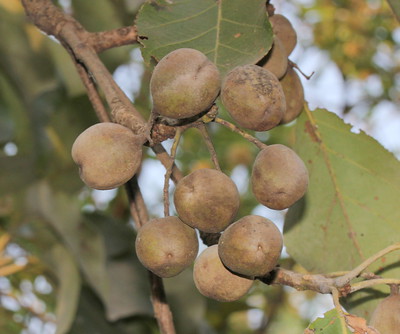
Behada is also know as beleric. It is a very popular Indian fruit for rejuvenation in combination of Trifla.
Latin name : Terminalia Bellirica
Family name : combrataceae
Sanskrit name : Bibhitaki, aksha, karshafal, kalidrum, bhutvaas, kaliyugalaya.
English name : Beleric myrobalan / beach almond / Behda nut tree
Hindi name : Bhutvass / Karsh phal / kalk / phinasa
Marathi name : Behada / ghaatinga
Telagu name : karshphalamu / tadichettu / vibhitakmu
Gujrati name : beda
Arabic name : baleelaj
Urdu name : behara
Nepali name : barro
विभितक: विगत भीत रोगभयमस्मात इति |
Myth about Bibhitaki : Bheeta means fear and Bibhitaki means the fruit that takes away the fear for diseases.
In northern India people are scared to sit under this tree shades, as it suppose to inhibited by demons.
Part used : Fruit, bark, seed oil, fruit cover.
Dose: 3-6 gram
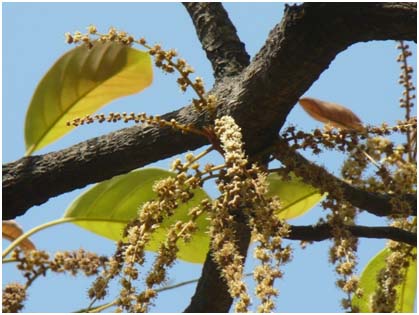
Why is Behada a medicinal fruit per Ayurveda?
As per acharya ‘Charaka’ Bibhitaki has the quality to alleviate diseases, & bestow longevity, improves intelligence & strength.
There are several Rasayana medicine described in Charaka Samhita which includes Behada.
In ‘Mahabharata’ for playing, Behada’s nuts were used as a dice.
Behada is mind-alerting fruit. Behada fruit resembles same as like a Haritaki.
What are the qualities of Behada?
बिभीतकं स्वादुपाक कषाय कफपित्तनूत | उष्ण वीर्य हिमस्पर्श भेदन कासनाशनंम ||
- Rasa (taste):Kashaya (Astringent)
- Vipaka (taste after digestion): Madhura (Sweet)
- Virya (potency): Ushna (Hot)
- Sparsh (touch): Sheet (Cold)
- Rooksha – Dry
- Laghu – Light
- Effect on tridosha: Balances kapha and pitta.
- Pharmacological activity: Antioxidant, anticancer, antipyretic, hepatoprotective, antihypertensive, antidiarrheal.
Behada Fruit qualities:
- Half ripped – Used as a laxative.
- Fully ripen or dry – Use for constriction.
- Especially for eye disorders, throat infection, piles, diarrhea, psoriasis.
- Inner parts of seeds (Majja) – painkiller, anti-inflammatory, sedative.
- Oil of seeds – Useful in preventing graying of hair, nutritive for hairs, anti-itching, and reduce burning.
- Outer fruit cover or inner seed part (Majja) – if roasted dry and placed in the mouth for instant, results in coughing & asthma.
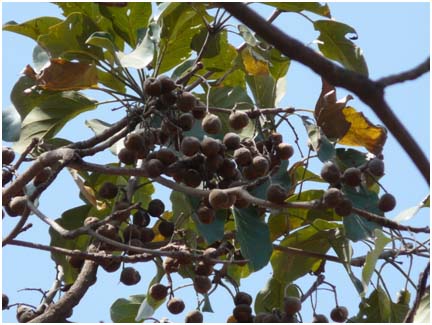
How is Behada used? In which forms, powder, juice, raw, paste?
- Powder form we can use – for cough, cold, fever, asthma attacks with honey or warm water or ghee. We can use powder for anti-addiction also into Luke warm water.
- Behada fruit or bark decoction – useful in asthma, cough, psoriasis, anemia, vitiligo.
- Raw – used as laxative. (with warm water after meal)
- Outer cover of fruit – useful in runny nose, cough, throat congestion. (With honey or warm water twice a day)
- Paste of bark or fruit we can use to make oil.
- Dry roasted fruit – useful for diarrhea and eye disorders.
Behada is used to cure which diseases?
As per acharya Charaka:
- Jwarahara: Group of herbs that used to treat fever.
- Kasahara: Group of herbs used to treat cough and cold.
- Virechanopaga: Group of herbs used for purgation therapy.
रूक्ष नेत्रहितम केश्यम कृमिवेस्वर्या नाशनम | बिभीतमज्जात्रुट छ्ऱ्दी कफवातहरी लघु: || भावप्रकाश 36
- Netrya – useful in all eye disorders.
- Keshyam – useful in hair problems.
- Krimi-nashak – useful for intestinal worms as a worm killer.
- Swar-nashak – useful in throat congestion and to improve the voice quality.
- Trushna-nashak – reduce thirst.
- Vamana -nashak – reduce vomiting. (anti-emetic)
- Kapha-vata nashak – reduce excess kapha and vata.
- Gall-bladder inflammation – decoction with ghee.
- Anorexia and indigestion – with ghee / warm water.
- Diarrhea – with clove powder & honey.
- Fever and fainting – decoction with ghee.
- Cough & mucus – vasa, Behada& licorice decoction with pinch of black salt.
Are there any side effects of Behada?
There is no side effect of Behada, but while using make sure you are using it with right combination (Anupan) and right doses under medical supervision.
Is Behada used alone or in combination with other fruits or ingredients?
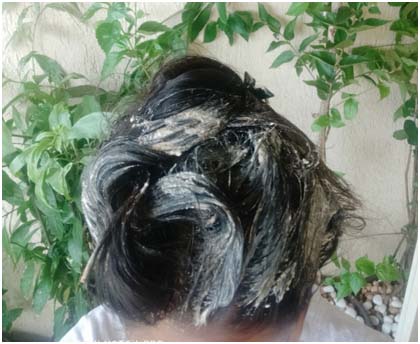
Behada we can use alone and also with combination also for wonderful results for lots of problems.
Some are the best example of using Behada are following:
- Cough and cold: ¼- ½ tsp powder mix with honey twice a day after meal.
- For bloating / constipation: Behda powder with 10 ml warm water after dinner.
- To reduce the addiction of tobacco: Behada powder is used as a replacement to tobacco or we at Vishwamukta Ayurveda use it with special method by churning tobacco with the decoction of Behada powder multiple times to reduce the potency of tobacco.
- Behada powder mix with Shikekai and Reetha are useful as a hair cleanser.
- Behada powder with warm water useful for weight loss.
- Behada powder with honey useful in hoarseness of voice.
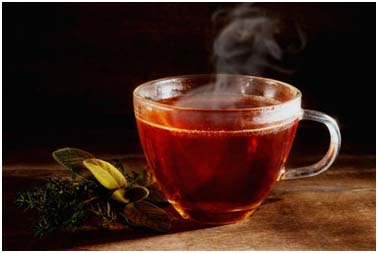
This was just a small introduction to what Ayurveda has in it’s treasure trove for all of use.
In this part we have discuss about Triphala’s three miraculous fruits separately.
Rather than this there are multiple combinations and alone triphala also has multiple benefits towards diseases. In the coming articles we will come up with more such wonderful information for you.
We hope the knowledge presented in this article was an eye opener and would encourage you to follow the wonderful lifestyle Ayurveda offers for living a healthy and joyous life.
Image credits Image credits Image credits
Written By…
|
Dr. Pallavi Shinde is the director at Shree Vishwamukta Yog, Ayurved and Panchakarma Clinic at Pune, India. She always uses ayurvedic proprietary formulations for many chronic health diseases & many products for Skin Diseases & beauty products. She is a hardcore Researcher, Practitioner, Promoter of Ayurveda. Contact today to book an appointment. |

